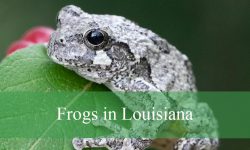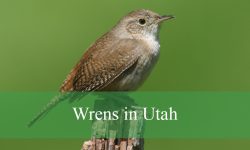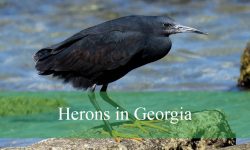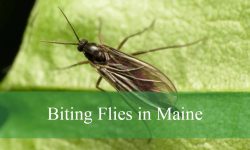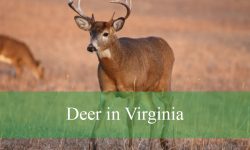Pennsylvania is home to a diverse array of bird species, with 47 common birds that you can spot across its forests, fields, and urban areas. This guide highlights each bird’s key features, behavior, and habitat to help you identify them with ease.
From vibrant songbirds to sturdy woodpeckers, these birds play an essential role in Pennsylvania’s ecosystem. Clear identification tips and photos will help bird enthusiasts of all levels recognize and appreciate these feathered residents.
Types of Birds Found in Pennsylvania
Rose-breasted Grosbeak
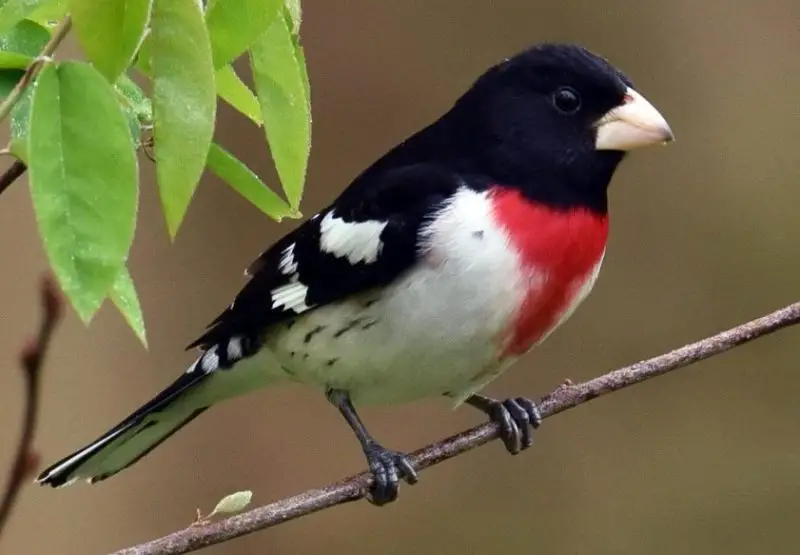
The Rose-breasted Grosbeak is a robust songbird with a striking appearance; males have a black head, back, and wings with a bright rose-red patch on the breast and white underparts. Females are more subdued, with brown streaking and a pale, warm-toned breast. Both sexes have large, conical bills adapted for cracking seeds.
They measure around 7 to 8.3 inches in length with a wingspan of 11.4 to 14.6 inches. Their song is rich and melodious, often compared to that of the American Robin but sweeter and more varied. These birds forage in trees and shrubs, feeding on insects, seeds, and fruits.
In Pennsylvania, Rose-breasted Grosbeaks are summer residents found in deciduous forests, woodland edges, and suburban areas with mature trees. They migrate to Central and South America for the winter. Their bold colors and beautiful song make them a favorite among bird enthusiasts.
Northern Cardinal

The Northern Cardinal is one of the most recognizable birds in Pennsylvania, known for its vivid coloration and striking profile. Males display bright red plumage with a black mask around the face and a thick orange bill, while females are a warm tan with hints of red on the wings, tail, and crest. Both sexes have a distinctive crest on their head that adds to their bold appearance.
This bird typically measures between 8.3 and 9.1 inches in length and has a wingspan ranging from 9.8 to 12.2 inches. It produces a series of clear, whistling notes that are often heard in early mornings. Cardinals are year-round residents and do not migrate, often seen perched in low shrubs or foraging on the ground for seeds, insects, and berries.
In Pennsylvania, Northern Cardinals are commonly found in dense thickets, woodland edges, gardens, and suburban neighborhoods. They adapt well to human presence and frequently visit bird feeders, especially in winter. Their bright color and sweet songs make them a favorite among birdwatchers and backyard enthusiasts.
American Robin

The American Robin is a familiar and widespread bird across Pennsylvania, especially noticeable in the spring. It has a round body with a rust-orange breast, gray back and head, and a yellow bill. Its cheerful song and hopping movements on lawns make it easy to recognize.
Adults typically measure about 9 to 11 inches long with a wingspan of 12 to 16 inches. They are early risers, often singing at dawn, and feed primarily on earthworms, insects, and various fruits. Juveniles are marked with a spotted breast and duller tones compared to adults.
American Robins are highly adaptable and inhabit a variety of environments including parks, gardens, forests, and fields. While many migrate south for the winter, some robins remain in Pennsylvania year-round, especially where berries and water are accessible. Their presence signals the changing seasons and adds life to both urban and rural settings.
Blue Jay
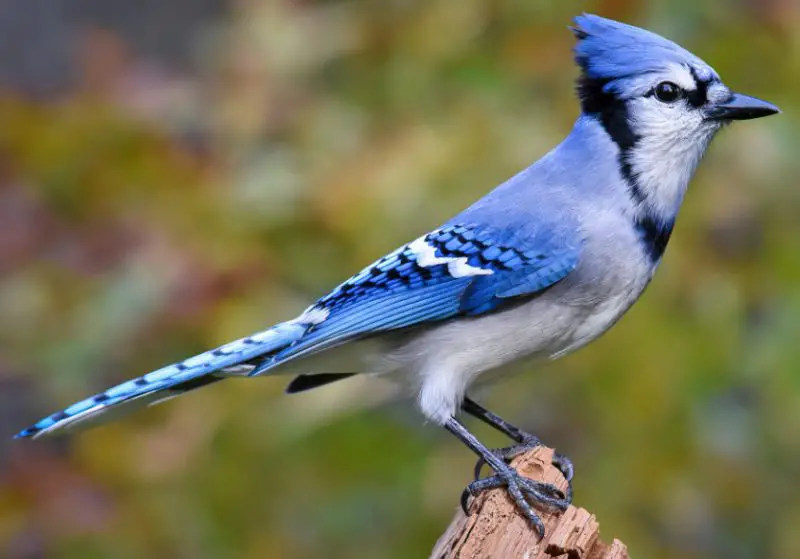
The Blue Jay stands out with its bright blue feathers, bold personality, and loud calls. Its body is accented with white and black patterns, a black “necklace” across the chest, and a prominent blue crest on its head. These birds are intelligent and curious, often alerting other birds of danger with their vocalizations.
They range in size from 9 to 12 inches in length with a wingspan between 13 and 17 inches. Blue Jays are known to mimic the calls of hawks and will often dominate backyard feeders. They feed on a variety of foods including acorns, seeds, insects, and occasionally small vertebrates.
In Pennsylvania, Blue Jays live in deciduous and mixed forests, suburban neighborhoods, and areas with mature trees. They are permanent residents and often store food in the fall, hiding acorns in the ground or tree bark. Their energetic behavior and vivid coloring make them a dynamic part of Pennsylvania’s birdlife.
Mourning Dove

The Mourning Dove is a gentle-looking bird with soft gray-brown plumage and a slender body. It is easily recognized by its long, pointed tail edged in white and the black spots on its wings. Its soft, mournful cooing gives the species its name and is often heard in quiet, open areas.
This bird measures between 9 and 13 inches in length with a wingspan of about 17 to 18 inches. Its flight is fast and direct, with a distinctive whistling sound made by the wings. Mourning Doves forage primarily on the ground, feeding on seeds and occasionally grains and berries.
They are common throughout Pennsylvania, frequently seen in farmland, suburban areas, open woods, and along roadsides. Mourning Doves are among the most hunted game birds in North America, yet they maintain high populations thanks to their prolific breeding and adaptability to human-altered habitats.
Black-capped Chickadee

The Black-capped Chickadee is a small, charming bird with a round body, black cap and bib, white cheeks, and soft gray back. Despite its size, it has a bold personality and is often one of the first birds to explore feeders or investigate human presence.
These birds are 4.7 to 5.9 inches long with a wingspan between 6.3 and 8.3 inches. They are known for their distinctive “chick-a-dee-dee-dee” call and their two-note “fee-bee” song, often heard in woodlands. Chickadees are agile and acrobatic, frequently seen hanging upside down as they forage.
In Pennsylvania, Black-capped Chickadees reside in deciduous and mixed forests, especially in cooler northern regions. They are year-round residents and adapt well to suburban areas with trees. Their ability to cache food and remember its location helps them survive harsh winters, making them a fascinating subject for birdwatchers.
Tufted Titmouse
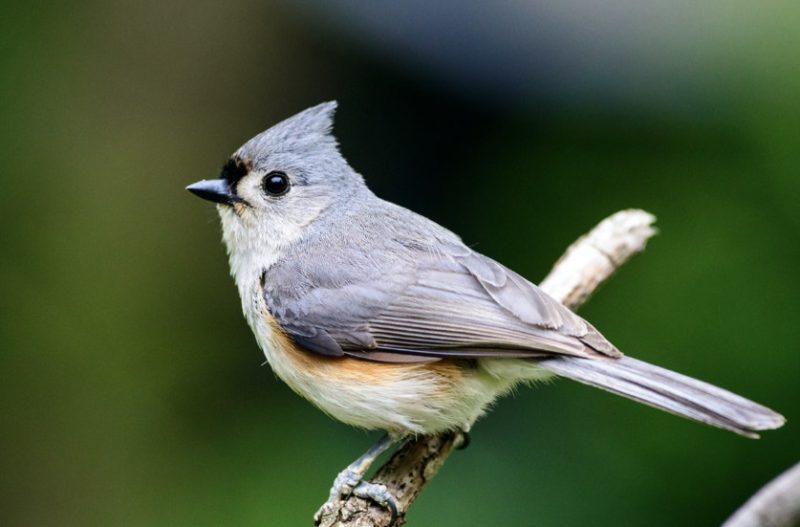
The Tufted Titmouse is a small songbird with a soft gray back, white underparts, and a noticeable tuft or crest on top of its head. It has large black eyes, a short stout bill, and a hint of rust coloration on its flanks. Its expressive face, highlighted by the crest and pale facial features, gives it a curious and alert appearance.
Measuring about 5.5 to 6.3 inches in length with a wingspan of 7.9 to 10.2 inches, the Tufted Titmouse is agile and quick. Its song is a clear whistled “peter-peter-peter” repeated in succession, often heard in wooded neighborhoods and parks. These birds are frequent visitors at feeders, especially where sunflower seeds, peanuts, or suet are offered.
In Pennsylvania, Tufted Titmice are year-round residents found in deciduous woodlands, forest edges, and well-treed suburban areas. They often forage in mixed flocks with chickadees and nuthatches, moving energetically through branches in search of insects, seeds, and nuts. Their curious behavior and soft calls make them easy to spot once you recognize their sound.
Downy Woodpecker

The Downy Woodpecker is the smallest woodpecker in North America and a common sight throughout Pennsylvania. It has black and white plumage, with a white underside, a black back marked with white spots, and a white stripe down the center. Males also have a small red patch on the back of the head, which females lack.
This species measures about 5.5 to 6.7 inches long with a wingspan of 9.8 to 11.8 inches. Despite its small size, the Downy Woodpecker produces a strong drumming sound as it taps on trees, fence posts, or feeders. It has a sharp “pik” call and often clings to small branches, using its stiff tail feathers for support while foraging.
In Pennsylvania, Downy Woodpeckers inhabit deciduous forests, wooded suburbs, parks, and orchards. They are common at suet feeders and also feed on insects, larvae, and seeds. These adaptable birds are active throughout the year and can be seen even in the coldest months, often foraging alongside other small songbirds.
Red-bellied Woodpecker
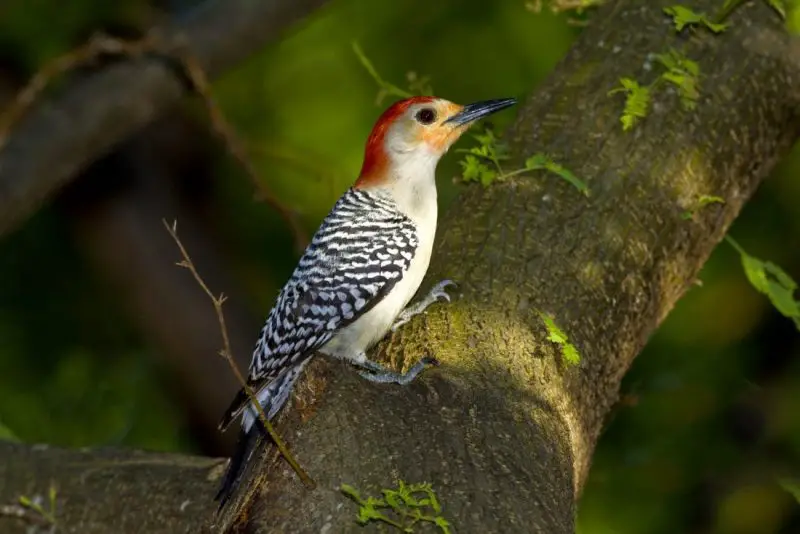
The Red-bellied Woodpecker is a striking and noisy bird with bold black-and-white barring on its back and wings. Despite its name, the red on its belly is faint and often hidden, while the most visible red appears on the crown and nape of the head, especially in males. Its face and underparts are pale with a slightly gray wash.
This medium-sized woodpecker measures between 9.4 and 10.6 inches in length and has a wingspan of 13 to 16.5 inches. Its call is a loud, rolling “churr” or “kwirr,” and it frequently drums on tree trunks. Red-bellied Woodpeckers are excellent climbers and use their long tongues to extract insects from crevices in bark.
They are commonly found throughout Pennsylvania in mature deciduous forests, woodlots, and wooded suburban areas. These birds are regular visitors to backyard feeders where they enjoy suet, nuts, and fruit. Their strong presence and vocal behavior make them one of the most easily noticed woodpeckers in the region.
White-breasted Nuthatch
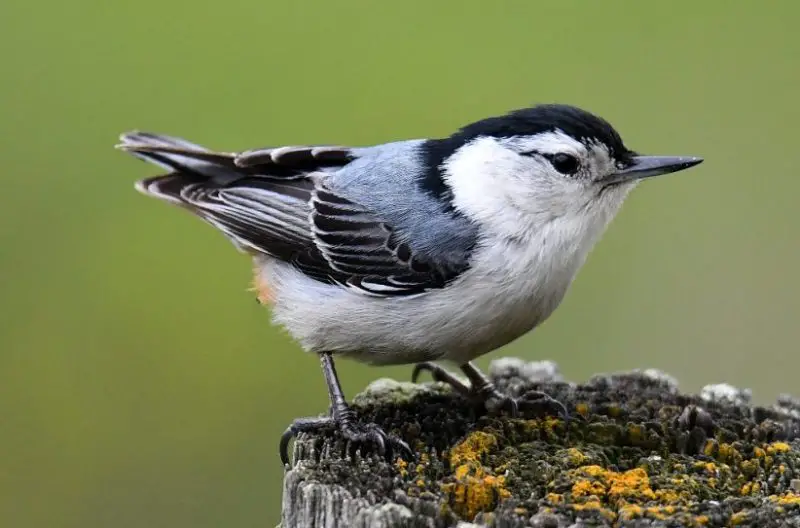
The White-breasted Nuthatch is a compact, active bird with a black cap, white face and underparts, and a bluish-gray back. It has a short tail and a long, slightly upturned bill. Its name comes from its habit of wedging seeds into bark and “hatching” them open with its bill.
This species is about 5.1 to 5.5 inches long and has a wingspan of 7.9 to 10.6 inches. It often climbs down tree trunks headfirst, a behavior that sets it apart from woodpeckers and other tree-foraging birds. Its call is a nasal “yank-yank” sound, frequently heard as it hops among branches in search of food.
In Pennsylvania, White-breasted Nuthatches are year-round residents of mature deciduous forests, as well as wooded suburbs and parks. They feed on insects, spiders, and seeds, and are common visitors to bird feeders, especially in winter. Their acrobatic movement and bold personality make them enjoyable to watch up close.
House Sparrow
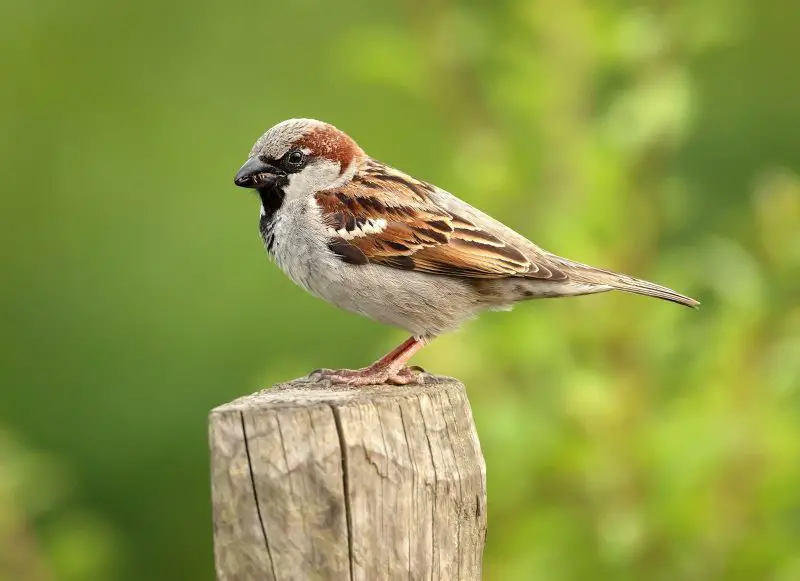
The House Sparrow is a small, stocky bird introduced from Europe in the 1800s and now widespread across Pennsylvania. Males have gray heads, white cheeks, a black bib, and chestnut-colored napes, while females and young birds are brown with duller streaks and plain faces.
They range from 5.9 to 6.7 inches in length with a wingspan of 7.5 to 9.8 inches. House Sparrows are social birds, often found in flocks near buildings, streets, farms, and city parks. Their chirping calls are sharp and frequent, creating a constant background sound in urban environments.
In Pennsylvania, House Sparrows are most common around human habitation. They nest in building crevices, vents, or nest boxes, often competing with native birds for space. Though not native to North America, they have become deeply integrated into urban and suburban life, making them one of the most observed birds in the state.
European Starling
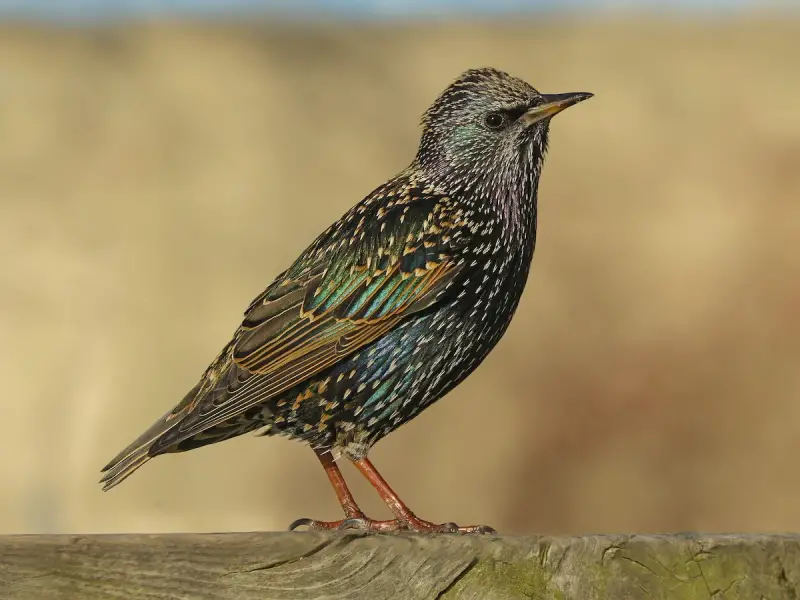
The European Starling is a medium-sized, highly social bird with glossy black plumage that shimmers with purple and green iridescence in the sunlight. In winter, their feathers are speckled with white spots, giving them a dappled look. They have short tails, pointed wings, and long, slender yellow bills that darken in the colder months.
Starlings typically measure about 7.9 to 9.1 inches in length with a wingspan of 12 to 16 inches. They are known for their ability to mimic the calls of other birds and even mechanical sounds. These birds often move in large, noisy flocks and perform spectacular aerial displays called murmurations, especially before roosting in the evening.
In Pennsylvania, European Starlings are found throughout cities, farms, and open countryside. They nest in cavities, often displacing native birds, and feed on insects, grains, and fruit. Though not native to North America, they are now among the most abundant and widespread birds in the state, thriving in both urban and rural settings.
Song Sparrow
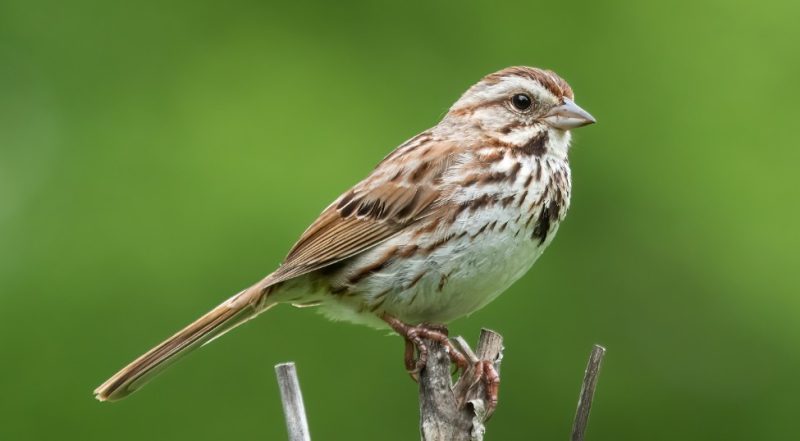
The Song Sparrow is a medium-sized, streaky brown bird with a rounded head and a long, rounded tail. Its most distinguishing features include a gray face with a dark line through the eye, and bold brown streaks on a white breast that often form a central dark spot. Its plumage can vary slightly depending on the region.
This bird measures between 4.7 and 6.7 inches long with a wingspan of 7.1 to 9.4 inches. As its name suggests, the Song Sparrow has a rich and varied song, typically beginning with several clear notes followed by a jumbled trill. Males sing from exposed perches during the breeding season to mark territory and attract mates.
In Pennsylvania, Song Sparrows are widespread across a variety of habitats including fields, marsh edges, gardens, and forest clearings. They are year-round residents and feed on a mix of seeds and insects. Their adaptability and pleasant song make them one of the most frequently heard and observed sparrows in the state.
House Finch
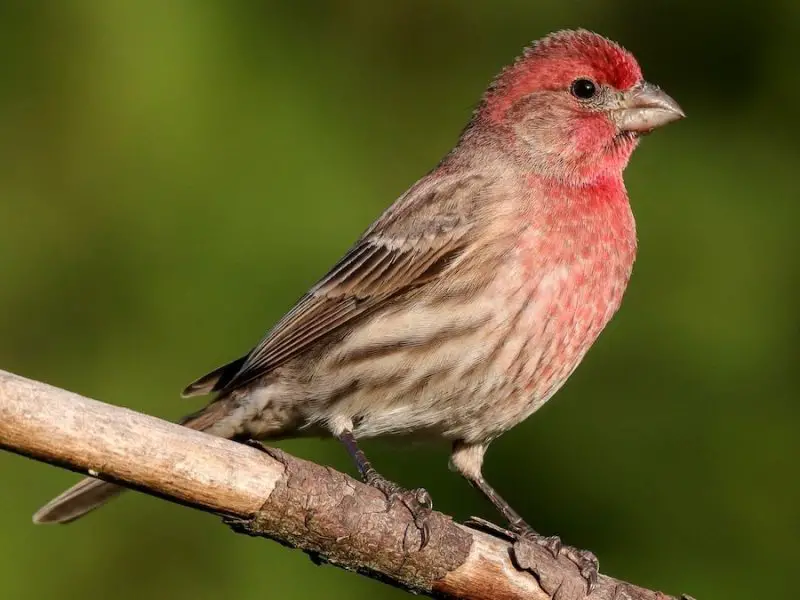
The House Finch is a small, colorful bird known for its cheerful presence around homes and feeders. Males are recognized by their rosy red faces, throats, and chests, which contrast with brown-streaked backs and bellies. Females lack the red coloration and are more uniformly streaked with brown and gray tones.
These birds measure about 5 to 6 inches long with a wingspan of 8 to 10 inches. Their song is a sweet, warbling series of notes and trills, often heard from rooftops, power lines, or trees. House Finches are highly social and are usually seen in small flocks, especially around food sources.
In Pennsylvania, House Finches are common in suburban and urban areas, especially near feeders. They nest in eaves, hanging planters, and ledges, and feed on seeds, buds, and fruits. Originally native to the western United States, they have successfully expanded eastward and are now well-established across the entire state.
American Goldfinch
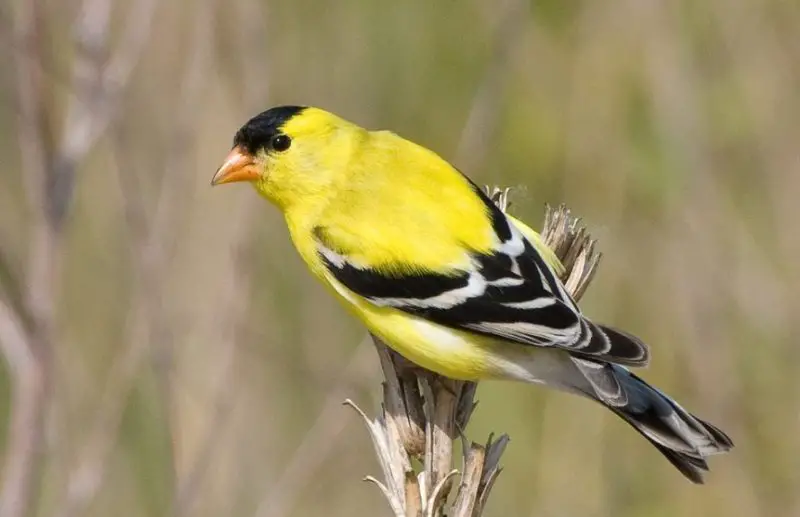
The American Goldfinch is a bright, cheerful songbird known for its vivid yellow plumage in males during the breeding season. Males have black wings with white markings and a black cap, while females are duller yellow-brown. In winter, both sexes molt into a muted olive-brown color that helps them blend into their surroundings.
This small finch measures about 4.3 to 5.1 inches long with a wingspan of 7.5 to 8.7 inches. Its song is a series of twitters and warbles, and its flight pattern is bouncy, often accompanied by a soft “per-chick-o-ree” call. Goldfinches are late breeders, nesting in midsummer when thistle and other seeds are abundant.
American Goldfinches are found across Pennsylvania in open fields, meadows, gardens, and suburban areas. They are common feeder visitors, especially where nyjer or sunflower seeds are offered. Their bright colors and melodic calls make them a favorite among backyard birdwatchers.
Dark-eyed Junco
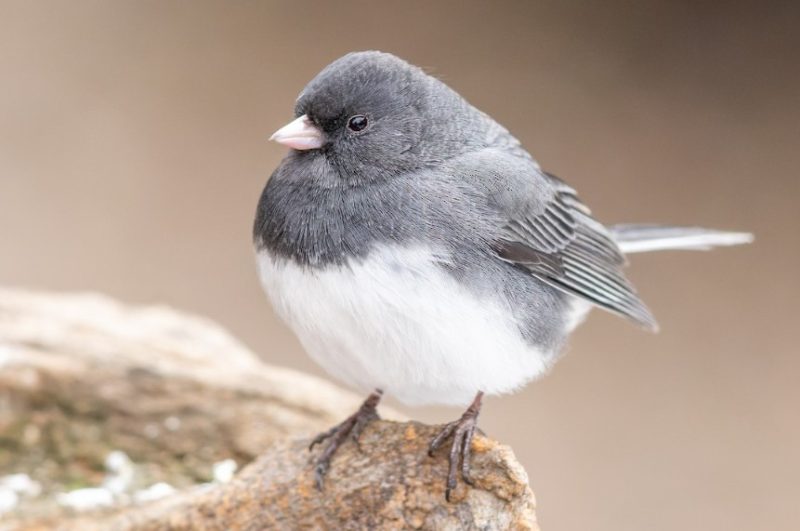
The Dark-eyed Junco is a small, ground-feeding sparrow most easily recognized by its dark gray head and back, white belly, and pale pink bill. Some individuals have brownish tones depending on their region or subspecies. Their crisp, contrasting coloration makes them easy to identify, especially in snow-covered landscapes.
These birds measure around 5.5 to 6.3 inches long with a wingspan of 7.1 to 9.8 inches. Juncos move in flocks during the winter and feed primarily on seeds. Their call is a short, dry “tick,” and their song is a simple, musical trill often delivered from a low perch during the breeding season.
In Pennsylvania, Dark-eyed Juncos are winter residents in most parts of the state and can be seen from late fall through early spring. They frequent wooded edges, gardens, and open areas, often scratching at the ground beneath feeders. Their seasonal appearance has earned them the nickname “snowbirds” among many bird enthusiasts.
Carolina Wren
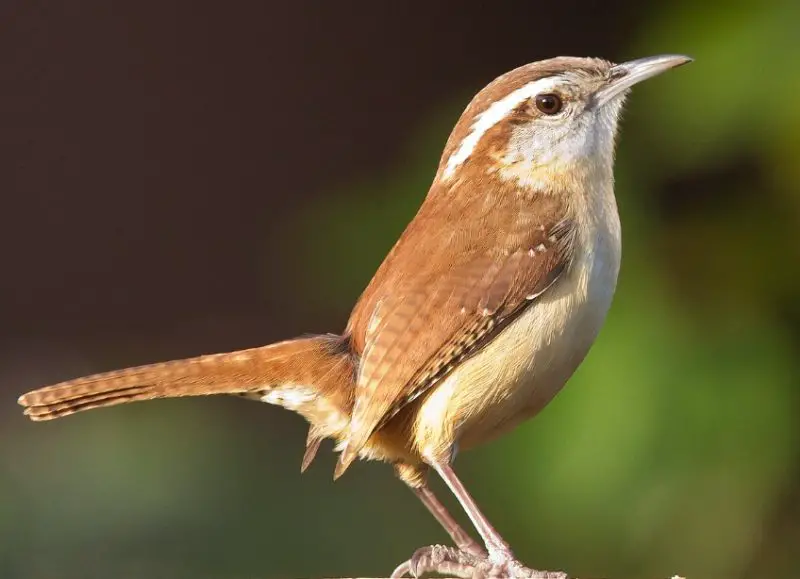
The Carolina Wren is a small, round-bodied bird with a rich cinnamon-brown back, warm buff underparts, and a prominent white eyebrow stripe. It has a slightly curved bill and a tail that is often cocked upward. Despite its small size, the Carolina Wren has a strong presence thanks to its bold posture and loud voice.
This bird measures about 4.7 to 5.5 inches in length with a wingspan of 11.4 inches. It sings a loud, whistled “teakettle-teakettle-teakettle” that can be heard echoing through woodlands and neighborhoods year-round. Carolina Wrens are extremely active, often seen hopping along logs, brush piles, or porches while searching for insects and spiders.
In Pennsylvania, Carolina Wrens are more common in the southern and central regions, especially in wooded residential areas, thickets, and brushy forests. Although sensitive to cold winters, their populations often rebound quickly due to their adaptability and multiple broods per year. They frequently nest in flowerpots, mailboxes, and other sheltered human-made structures.
Eastern Towhee
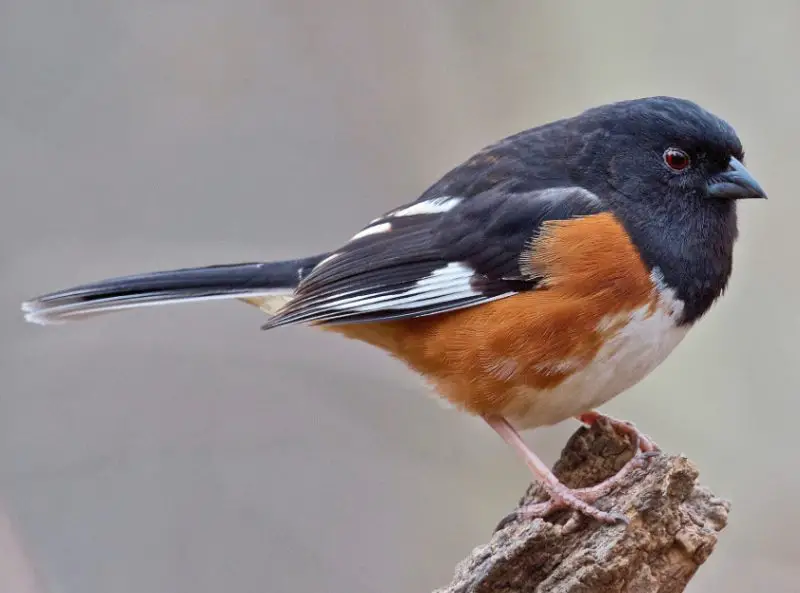
The Eastern Towhee is a large sparrow with bold coloration and striking eyes. Males are mostly black above with white underparts and rich rufous flanks, while females have the same pattern in brown tones. Both sexes have red eyes and a long, rounded tail with white outer edges.
They measure around 6.8 to 8.2 inches long with a wingspan of 7.9 to 11 inches. Eastern Towhees are known for their distinctive “drink-your-tea” song and sharp call notes. These birds spend much of their time on the ground, scratching in leaf litter with both feet in search of seeds, berries, and insects.
In Pennsylvania, Eastern Towhees are commonly found in shrubby forests, overgrown fields, and woodland edges. They are more easily heard than seen due to their tendency to stay hidden in dense vegetation. During the breeding season, males will sing from exposed perches, but for most of the year, they remain secretive and low to the ground.
Gray Catbird
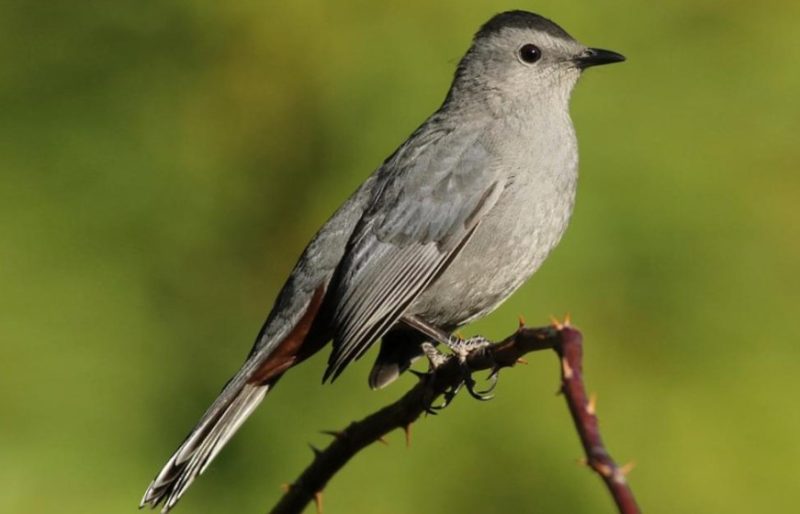
The Gray Catbird is a medium-sized, sleek bird with uniform slate-gray plumage, a black cap, and a rufous patch under the tail. It is named for its cat-like “mewing” call, which is one of many sounds in its wide vocal repertoire. The bird is slender with a long tail and subtle elegance in its posture.
Measuring about 8.3 to 9.4 inches in length with a wingspan of 8.7 to 11.8 inches, the Gray Catbird is a skilled mimic. It often sings a long, jumbled series of whistles, squeaks, and imitations of other birds, delivered from a well-hidden perch. Both males and females sing, especially during the breeding season.
In Pennsylvania, Gray Catbirds are summer residents found in thickets, forest edges, backyards, and shrublands. They nest low in dense vegetation and are frequently seen darting out to forage for fruit and insects. Their secretive nature and distinctive calls make them a favorite among attentive birdwatchers.
Northern Mockingbird
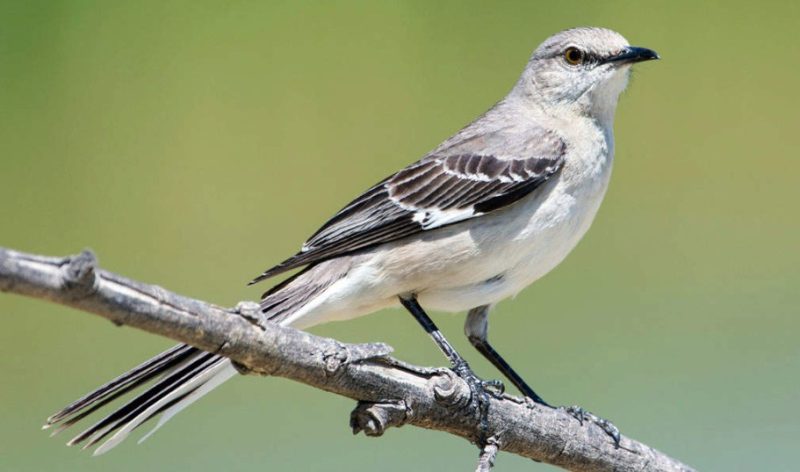
The Northern Mockingbird is a pale gray songbird with a long tail, slender body, and white wing patches that flash dramatically in flight. It has a white underbelly, thin black legs, and a sharp, slightly downcurved bill. Its tail is long and expressive, often flicked while it perches or walks.
Mockingbirds range from 8.1 to 10.2 inches in length with a wingspan of 12 to 15 inches. They are exceptional mimics, able to imitate dozens of bird species, insects, and even mechanical noises. Their songs are typically long and repetitive, delivered loudly from treetops, rooftops, or fence posts—day or night.
In Pennsylvania, Northern Mockingbirds are year-round residents mostly found in suburban neighborhoods, open fields with shrubs, and city parks. They are territorial birds, often seen chasing away intruders or even larger birds from their nests. Their remarkable vocal abilities and bold behavior make them stand out wherever they live.
Common Grackle
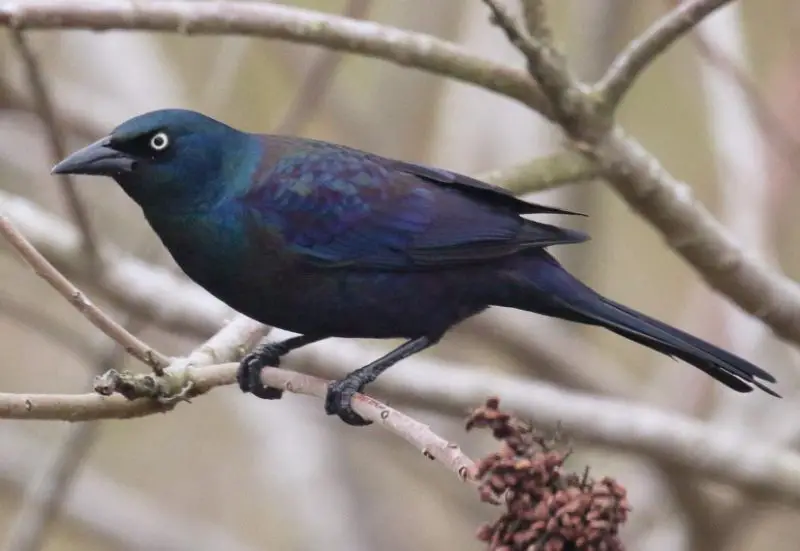
The Common Grackle is a large, glossy blackbird with a striking iridescent sheen that reflects purples, blues, and bronzes in the sunlight. It has a long, keel-shaped tail and pale yellow eyes that give it a piercing stare. Males are more iridescent than females, which appear duller with more bronze tones.
This bird typically measures between 11 and 13.4 inches long with a wingspan of 14 to 18.1 inches. Its song is a harsh, creaky series of whistles and squeaks, and its call is a loud “chack.” Grackles often forage in noisy flocks, walking boldly on lawns, fields, or parking lots in search of seeds, insects, and scraps.
Common Grackles are widespread across Pennsylvania, particularly in open fields, agricultural areas, wetlands, and suburban landscapes. They often nest in colonies in trees near water and are known to roost in large flocks. Though sometimes considered pests due to their boldness and crop foraging, their shimmering plumage and social behavior are undeniably eye-catching.
Brown-headed Cowbird
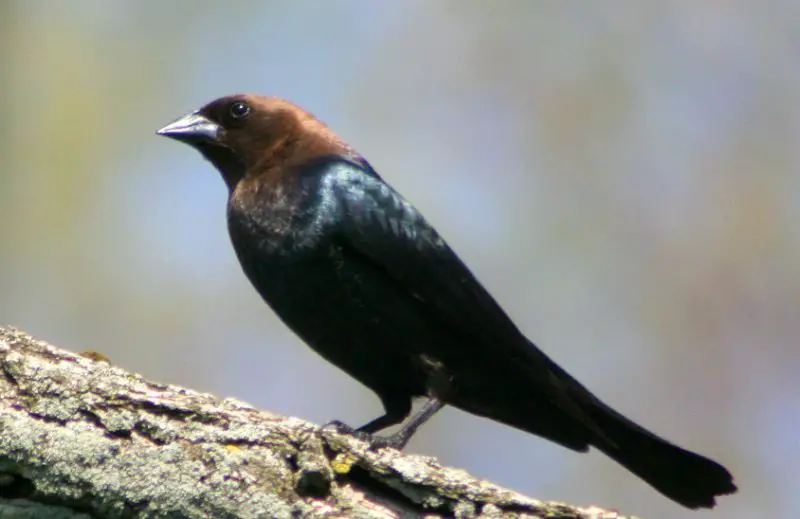
The Brown-headed Cowbird is a medium-sized blackbird notable for its sexual dimorphism. Males have glossy black bodies with a rich brown head, while females are mottled brown and gray, appearing more subdued. The contrast between the male’s dark body and chestnut head makes it easily recognizable in Pennsylvania.
These birds measure approximately 7.5 to 9.1 inches in length with a wingspan of 12 to 15 inches. Brown-headed Cowbirds produce a bubbly, gurgling song and sharp calls often heard in open habitats. They are known for their brood parasitism, laying eggs in the nests of other bird species rather than building their own nests.
In Pennsylvania, Brown-headed Cowbirds inhabit open fields, pastures, forest edges, and suburban areas. They often follow grazing animals to feed on insects disturbed by the livestock. Their parasitic breeding strategy has significant effects on host species’ populations, making them a fascinating but sometimes controversial bird.
Chipping Sparrow
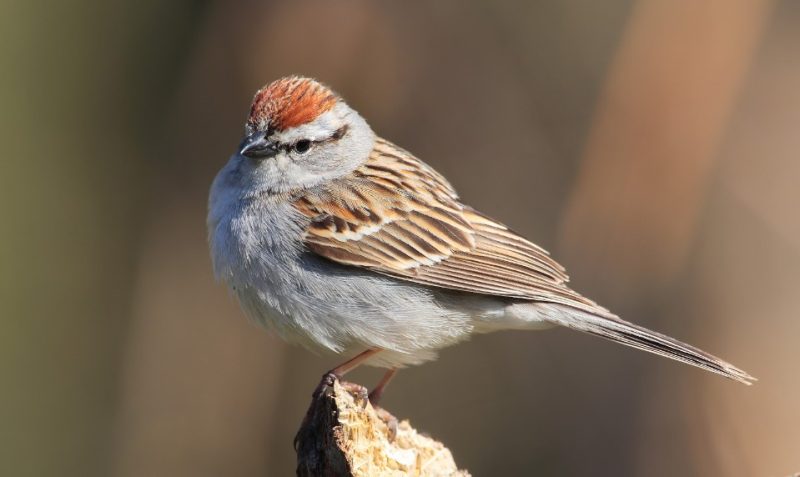
The Chipping Sparrow is a small, slender bird with a distinctive rusty cap, gray face, and black eye line. Its underparts are pale with fine streaking on the sides. This sparrow is commonly seen in open woodlands, parks, and suburban yards, especially during spring and summer.
Measuring about 4.7 to 5.9 inches in length with a wingspan of 7.5 to 8.7 inches, the Chipping Sparrow has a bright, mechanical trill song lasting several seconds. It forages mainly on the ground for seeds and insects, often in small flocks outside the breeding season.
In Pennsylvania, these sparrows are widespread breeders, favoring open pine forests, forest edges, and yards with scattered trees. They build neat cup-shaped nests in tree branches and are frequently attracted to backyard feeders. Their crisp, energetic song is one of the earliest signs of spring.
Eastern Bluebird
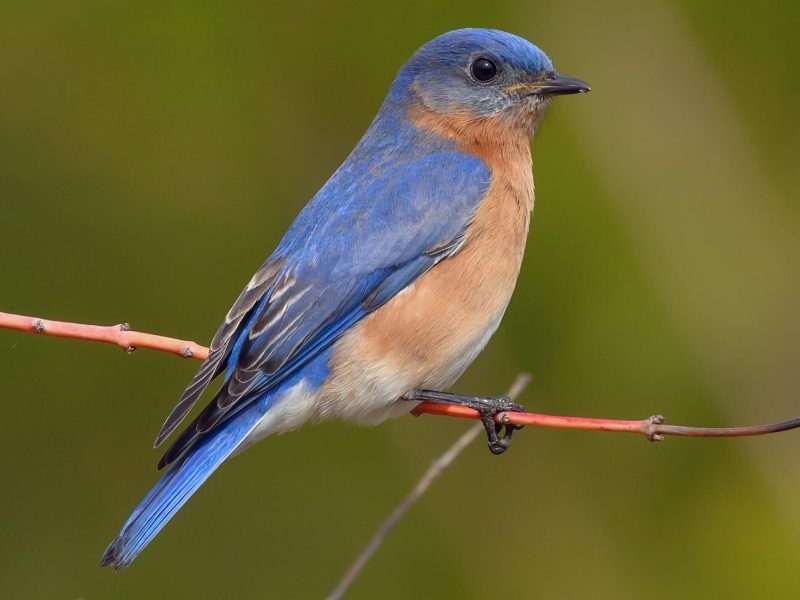
The Eastern Bluebird is a medium-sized thrush with striking bright blue upperparts and a warm rusty-orange throat and chest. Females have more muted colors, with grayish-blue wings and tail and paler underparts. Their gentle and serene appearance makes them a beloved species among birdwatchers.
They measure about 6.3 to 8.3 inches in length with a wingspan of 9.8 to 12.6 inches. Eastern Bluebirds are known for their soft warbling songs and melodious calls. They prefer open habitats with scattered trees and nest primarily in cavities or nest boxes, often competing with other cavity nesters.
In Pennsylvania, Eastern Bluebirds are common in meadows, orchards, parks, and suburban gardens. Conservation efforts, including the installation of nest boxes, have helped their populations recover from past declines. Their bright colors and friendly demeanor make them a welcome sight in both rural and urban areas.
Cedar Waxwing
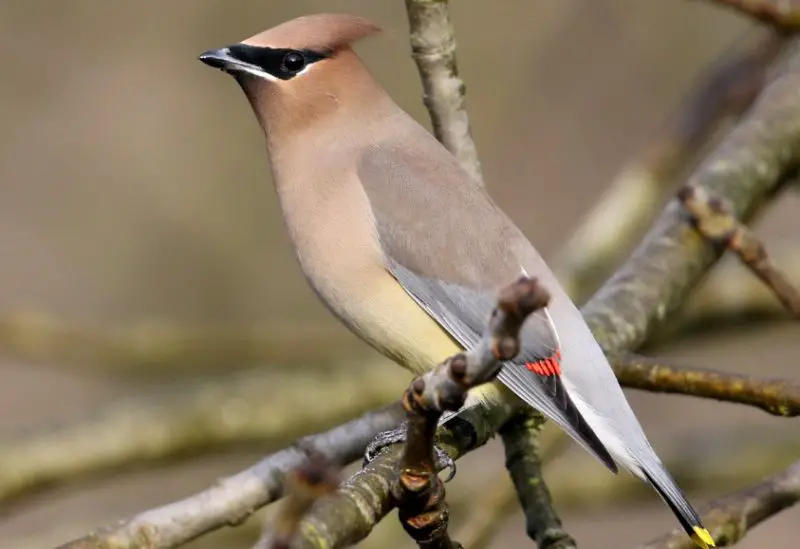
The Cedar Waxwing is a sleek, elegant bird with soft brown and gray plumage, a pale yellow belly, and distinctive red wax-like tips on its secondary wing feathers. It has a prominent black mask bordered with white, a crest, and a bright yellow tip on its tail. This bird’s smooth and silky appearance makes it stand out in Pennsylvania’s woodlands.
Measuring 6.3 to 7.1 inches long with a wingspan of 8.7 to 11 inches, Cedar Waxwings have a high-pitched, thin “sreee” call and a melodic warbling song. They are social birds, often seen in flocks, feeding primarily on fruit but also catching insects in flight during the breeding season.
In Pennsylvania, Cedar Waxwings inhabit open woodlands, orchards, gardens, and suburban areas. Their diet heavily relies on berries, making them important seed dispersers. Waxwings breed in loose colonies, building nests in dense shrubs or trees, and their gregarious nature is a delight to observe.
Baltimore Oriole
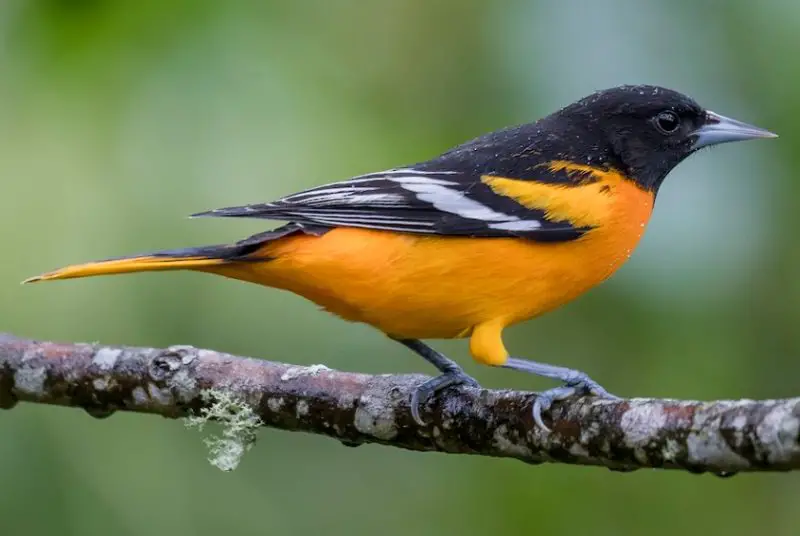
The Baltimore Oriole is a strikingly colorful bird known for its bright orange body contrasted with black wings and head in males. Females and immature birds are paler with yellow-orange underparts and grayish wings. Orioles have a slender, pointed bill adapted for feeding on nectar, fruits, and insects.
These birds measure about 6.7 to 7.5 inches in length with a wingspan of 9.8 to 12.6 inches. Baltimore Orioles have a flutelike, rich song composed of varied whistles and phrases. They are often seen fluttering through trees and shrubs searching for food, especially during spring and summer.
In Pennsylvania, Baltimore Orioles favor open woodlands, parks, and suburban areas with tall trees. They build intricate hanging nests woven from fibers and grasses, usually suspended from the ends of branches. Their vibrant colors and lively songs make them a favorite among bird enthusiasts and backyard birders.
Indigo Bunting
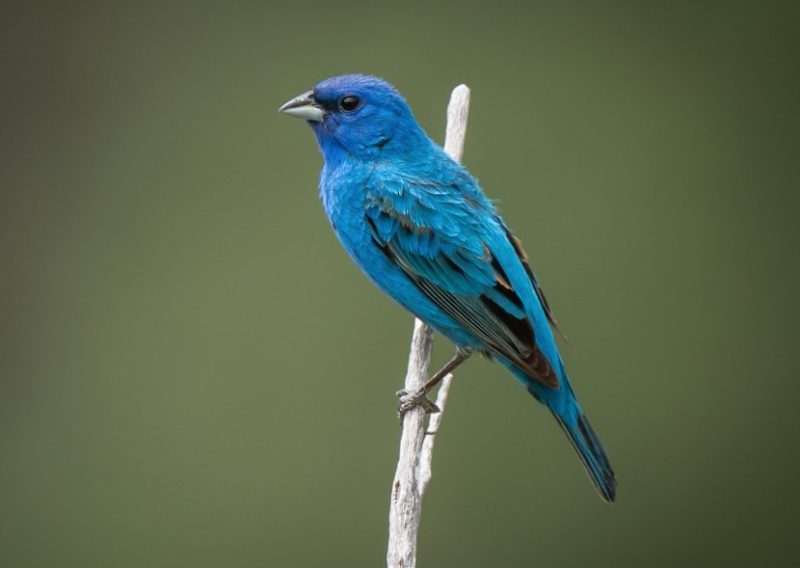
The Indigo Bunting is a small songbird famous for the male’s brilliant blue plumage that appears almost electric in sunlight. Females and immature birds are brown with faint streaks and hints of blue. This bird’s vivid coloration and melodic song make it a favorite among birdwatchers in Pennsylvania.
Measuring about 4.5 to 5 inches long with a wingspan of 7.5 to 9.1 inches, Indigo Buntings have a sweet, high-pitched warbling song. They forage mostly on the ground or in low bushes, feeding on seeds, berries, and insects. Their song is often heard from exposed perches during the breeding season, marking territory and attracting mates.
In Pennsylvania, Indigo Buntings prefer open woodlands, brushy fields, and forest edges. They migrate south for the winter but return in late spring to breed. Their striking blue plumage stands out against the green foliage, making them a cherished sight in spring and summer months.
Ruby-throated Hummingbird

The Ruby-throated Hummingbird is the only hummingbird species commonly found in Pennsylvania. Males are easily identified by their iridescent ruby-red throat patch, glossy green back, and white underparts. Females lack the red throat and have a more muted green and white coloration.
These tiny birds measure about 3 to 3.5 inches long with a wingspan of 3.1 to 4.3 inches. Known for their incredible flight skills, including hovering and rapid wingbeats, Ruby-throated Hummingbirds feed mainly on nectar from flowers and feeders, but also consume small insects for protein. Their high-pitched, buzzy calls and humming wings create a distinctive soundscape.
In Pennsylvania, Ruby-throated Hummingbirds arrive in late spring and remain through summer to breed. They favor gardens, forest edges, and meadows with abundant flowering plants. Their presence is a sure sign of warm weather, and they are beloved visitors at feeders stocked with sugar water.
American Crow
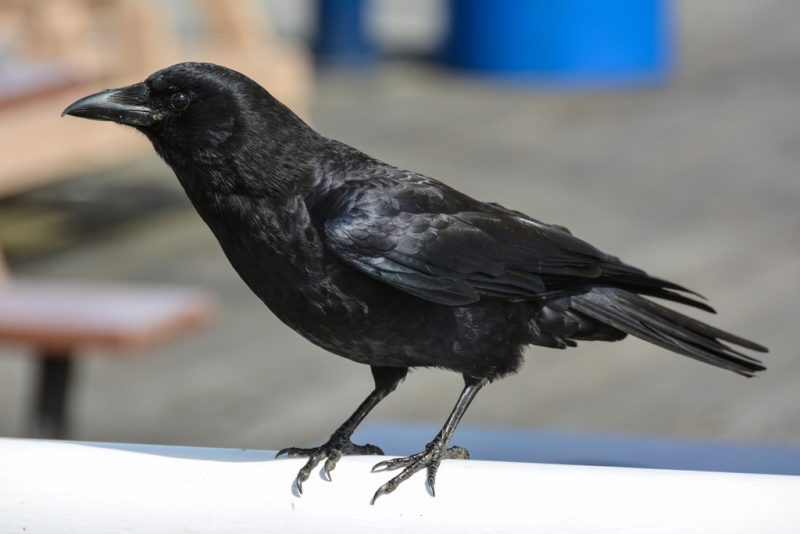
The American Crow is a large, all-black bird known for its intelligence, adaptability, and loud cawing calls. It has glossy black feathers, a stout bill, and a fan-shaped tail. Crows are social birds often seen in groups, sometimes forming large roosts especially in winter.
They typically measure 16 to 21 inches in length with a wingspan of 33 to 39 inches. American Crows have a wide variety of vocalizations beyond the familiar “caw,” including rattles and clicks. They are opportunistic feeders, eating everything from insects and small animals to carrion and human refuse.
In Pennsylvania, American Crows inhabit forests, farmland, suburban neighborhoods, and urban areas. Their remarkable problem-solving skills and complex social behaviors make them one of the most fascinating and successful birds in the region. They are permanent residents and are especially visible during the fall and winter months.
Fish Crow
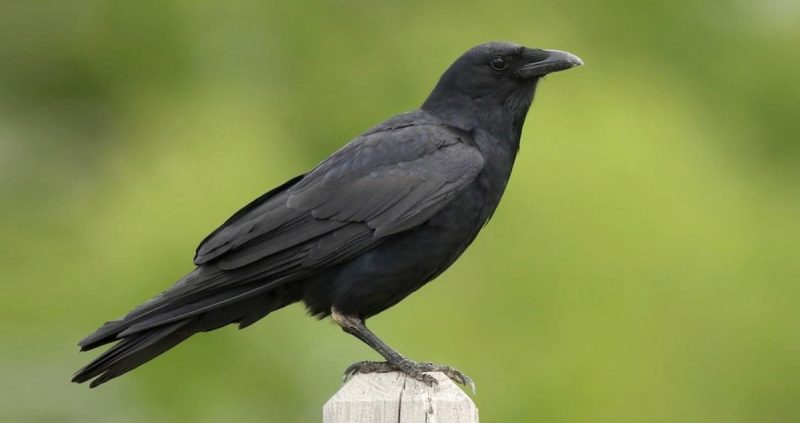
The Fish Crow is similar in appearance to the American Crow but smaller and with a more nasal, “nyah-nyah” call. It has glossy black plumage and a slightly smaller body, often seen near water sources. Fish Crows are more secretive and less widespread than American Crows but share many behavioral traits.
Measuring about 14 to 17 inches long with a wingspan of 33 inches, Fish Crows often gather in coastal areas, rivers, and wetlands. They are highly adaptable omnivores, feeding on fish, crustaceans, insects, and scavenged food. Their social structure includes group roosting and cooperative behavior.
In Pennsylvania, Fish Crows are mostly found in the southeastern and coastal regions, especially around Chesapeake Bay and river systems. They prefer habitats close to water but can also be spotted in urban waterfronts. Their distinctive voice and habitat preferences help distinguish them from their American Crow cousins.
Red-winged Blackbird
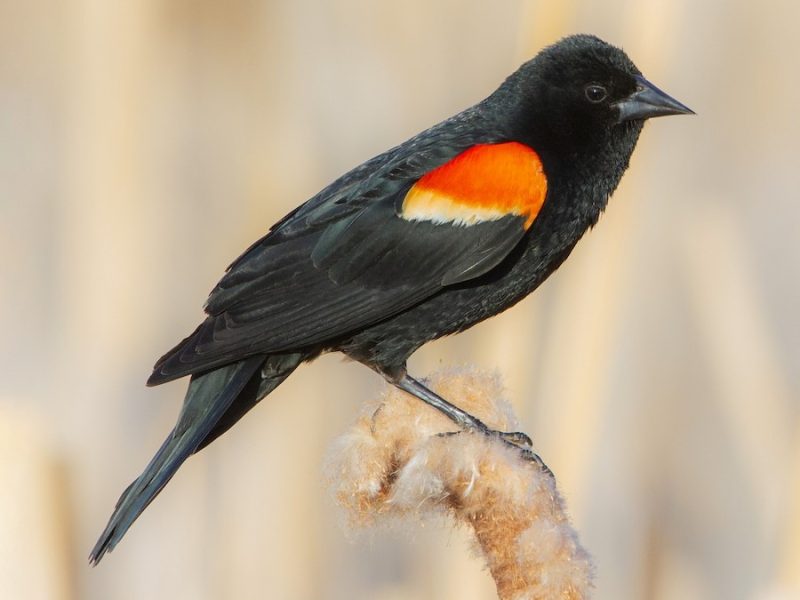
The Red-winged Blackbird is a common and easily identified bird, especially the males with their glossy black bodies and bright red and yellow shoulder patches called epaulets. Females are streaky brown with a pale eyebrow and lack the vibrant colors of males, providing excellent camouflage.
These birds measure about 7 to 9.1 inches long with a wingspan of 12.6 to 15.7 inches. Males perform dramatic displays by fluffing their red epaulets and singing loud, musical calls to defend territories during breeding season. They are often seen perched on cattails or fence posts near wetlands and marshes.
In Pennsylvania, Red-winged Blackbirds thrive in marshes, wetlands, fields, and agricultural areas. They are highly social, forming large flocks outside of the breeding season. Their distinctive calls and striking male plumage make them one of the most iconic birds of eastern North America.
Tree Swallow
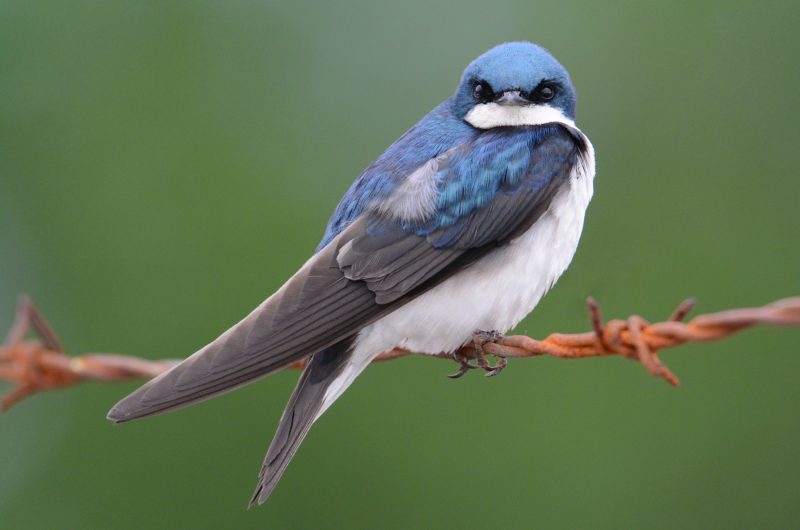
The Tree Swallow is a small, agile bird known for its iridescent blue-green upperparts and white underparts. It has a slightly forked tail and a short, flat bill adapted for catching insects in flight. The bird’s shimmering plumage and graceful aerial acrobatics make it a common and admired sight during Pennsylvania’s warmer months.
Tree Swallows measure about 5 to 6 inches in length with a wingspan of 11.8 to 13.8 inches. Their twittering calls and chattering songs are often heard near wetlands, ponds, and open fields where they forage. They primarily feed on flying insects but will also consume berries when insects are scarce.
In Pennsylvania, Tree Swallows arrive in spring and nest in tree cavities, nest boxes, and sometimes man-made structures. They prefer open habitats near water, including marshes and meadows. Their migratory behavior takes them south in winter, but their presence in summer adds dynamic movement to the skies.
Barn Swallow
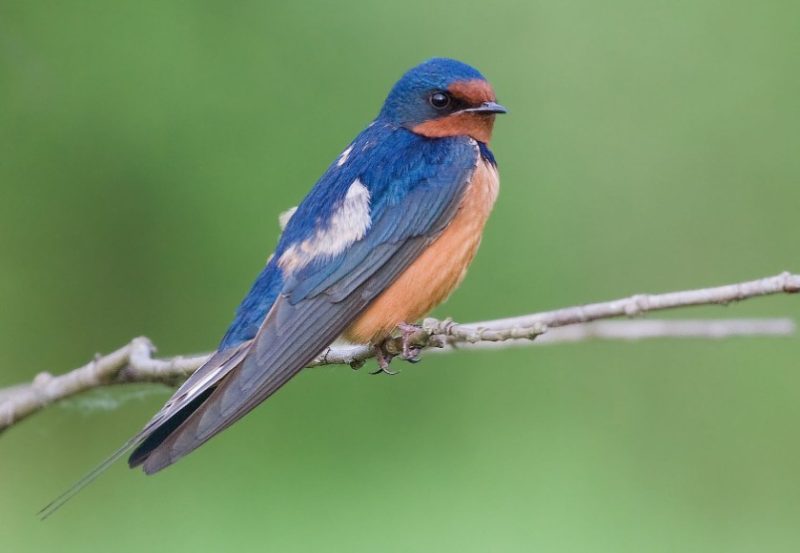
The Barn Swallow is easily recognized by its deeply forked tail and glossy blue upperparts contrasted with a reddish-brown throat and forehead. Its underparts are buffy or white, and the bird’s slender body and pointed wings make it a swift and graceful flier. Barn Swallows are often associated with human structures, especially barns and bridges.
Measuring about 7 to 8 inches long with a wingspan of 12 to 14 inches, Barn Swallows emit a series of cheerful, twittering calls and complex songs. They catch insects mid-air with exceptional agility, often skimming over fields, lakes, and roadsides. Their swift flight patterns and social behavior are a delight to observe.
In Pennsylvania, Barn Swallows nest in colonies attached to buildings or natural cliffs, favoring open countryside and farmland. They migrate south for the winter, returning in spring to breed. Their reliance on human-made structures for nesting sites shows their close relationship with agricultural landscapes.
Chimney Swift
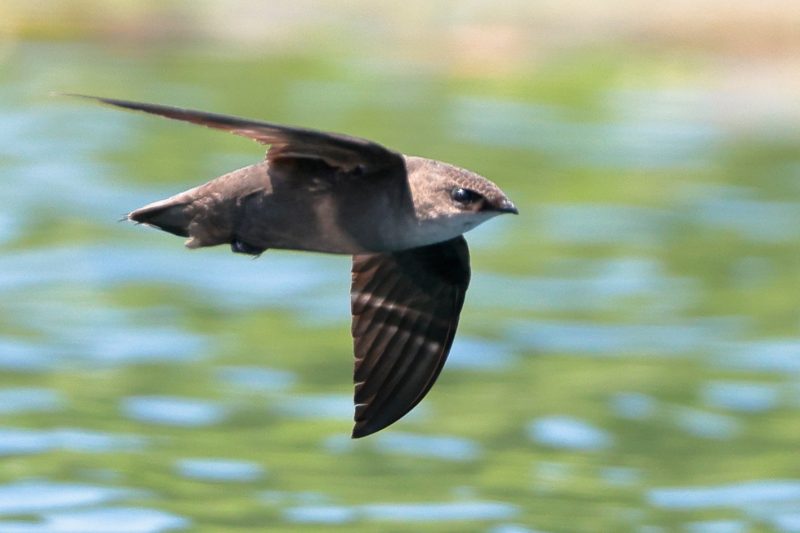
The Chimney Swift is a small, cigar-shaped bird with dark sooty gray plumage and long, narrow wings. It spends almost all its time in flight, rarely perching except on vertical surfaces. The swift’s rapid, erratic flight and squeaky calls are distinctive during Pennsylvania’s summer evenings.
These birds measure about 5 to 6 inches in length with a wingspan of 11 to 13 inches. Chimney Swifts feed exclusively on flying insects, catching them on the wing with remarkable precision. They nest in hollow trees or, more commonly in modern times, inside chimneys and other vertical shafts.
In Pennsylvania, Chimney Swifts are summer residents that arrive in late spring and leave by early fall. Their populations have declined somewhat due to changes in chimney usage and loss of natural nesting sites. Conservation efforts encourage providing suitable nesting habitats to help sustain their numbers.
Killdeer
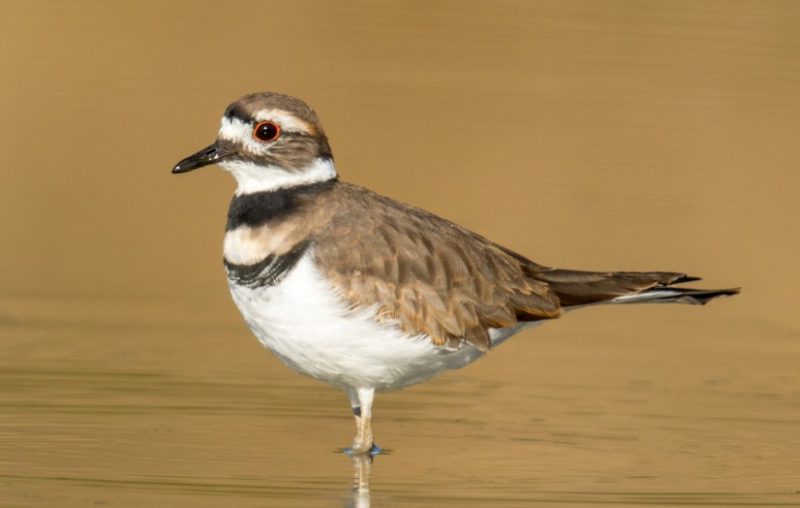
The Killdeer is a medium-sized plover with distinctive brown and white plumage and two black breast bands. It has a long tail with white edges and bright orange eyes that stand out against its pale face. Known for its dramatic “broken-wing” distraction display, the Killdeer is a clever and resourceful ground nester.
Killdeers measure about 8 to 11 inches long with a wingspan of 18 to 24 inches. Their call is a loud, high-pitched “kill-deer” whistle, which gives the species its name. They forage for insects, worms, and small invertebrates by running and probing the ground in open fields, lawns, and gravel areas.
In Pennsylvania, Killdeers are common in open habitats such as fields, shorelines, and even urban areas like parking lots and golf courses. They nest on bare ground or gravel, relying on camouflage and distraction behaviors to protect their eggs and chicks from predators.
Northern Flicker
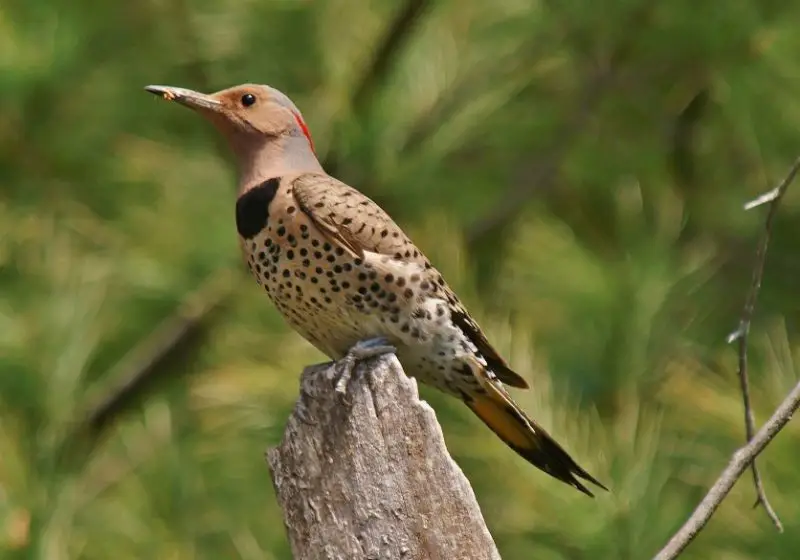
The Northern Flicker is a large woodpecker species with a brownish body adorned with black spots and bars, a white rump patch visible in flight, and a distinctive black bib on the chest. The males have a red or black mustache stripe depending on the regional subspecies. Unlike many woodpeckers, flickers often forage on the ground for ants and beetles.
These birds measure about 11 to 12 inches long with a wingspan of 16 to 20 inches. Their loud, rolling call and rhythmic drumming on trees are familiar sounds in Pennsylvania woodlands. Flickers are strong fliers and often perch openly on tree trunks, fence posts, or utility poles.
In Pennsylvania, Northern Flickers are year-round residents found in open woodlands, parks, suburban areas, and forest edges. Their preference for ground foraging and varied diet sets them apart from other woodpeckers. Their striking plumage and distinctive calls make them a notable member of the state’s bird community.
Pileated Woodpecker
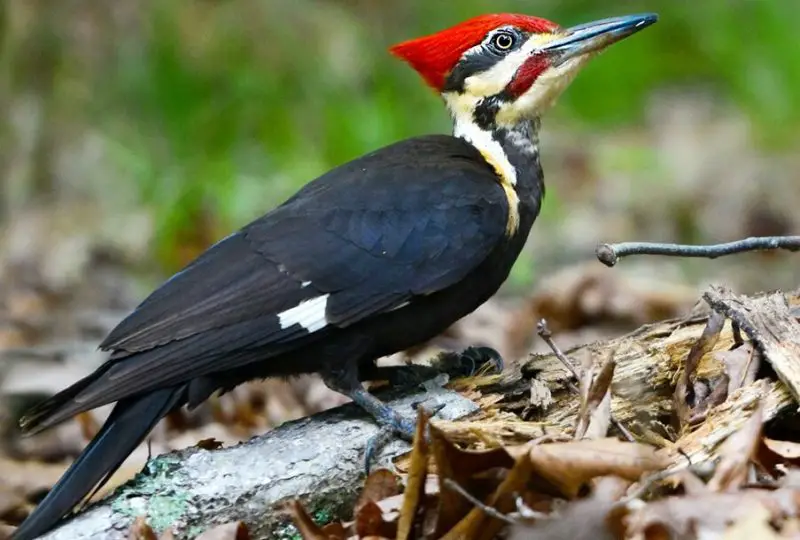
The Pileated Woodpecker is one of the largest woodpecker species in North America, easily recognized by its striking black body, white stripes on the face and neck, and a bright red crest on its head. It has a strong, chisel-like bill used to excavate large rectangular holes in dead trees to find insects, primarily carpenter ants and beetle larvae. Its loud, ringing call and distinctive drumming are iconic sounds of Pennsylvania’s mature forests.
This woodpecker measures about 16.5 to 19 inches in length with a wingspan ranging from 26 to 30 inches. Pileated Woodpeckers use their powerful bills to create nesting cavities and feeding sites, often leaving large, noticeable damage on trees. Their flight is characterized by slow, strong wingbeats alternating with glides.
In Pennsylvania, Pileated Woodpeckers inhabit mature deciduous and mixed forests, especially areas with large standing dead trees. They are year-round residents and play an important ecological role by controlling insect populations and providing nesting sites for other cavity-nesting species. Their striking appearance and deep calls make them a favorite among birdwatchers.
Hairy Woodpecker
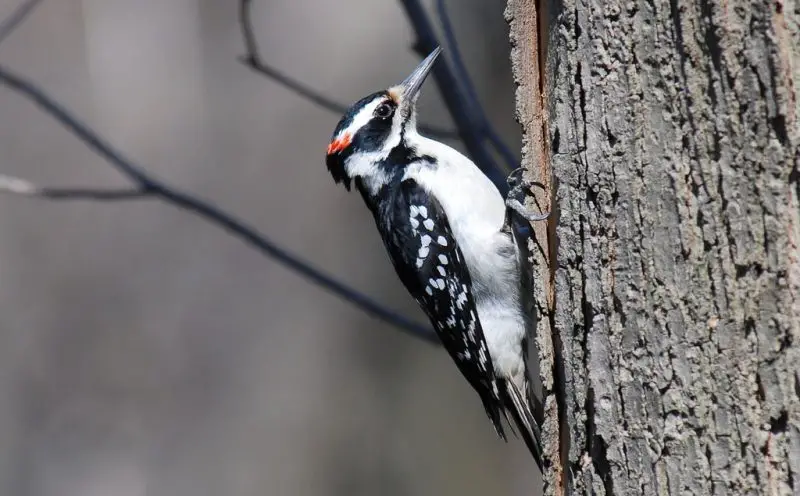
The Hairy Woodpecker is a medium-sized woodpecker with black and white plumage resembling the Downy Woodpecker but noticeably larger, with a longer bill relative to its head. It has a white belly, black wings with white spots, and a white stripe down the back. Males have a small red patch on the back of the head, while females lack this mark.
This species measures approximately 7 to 10 inches in length with a wingspan of 13 to 16 inches. Hairy Woodpeckers drum loudly on tree trunks to establish territory and locate food, which includes insects, larvae, and occasionally fruits and seeds. Their flight is direct with rapid wingbeats and a slightly undulating pattern.
In Pennsylvania, Hairy Woodpeckers are year-round residents found in a variety of wooded habitats including forests, parks, and suburban areas with mature trees. They prefer larger trees than Downy Woodpeckers for foraging and nesting. Their presence is often signaled by their sharp calls and drumming sounds throughout the forest.
Great Crested Flycatcher
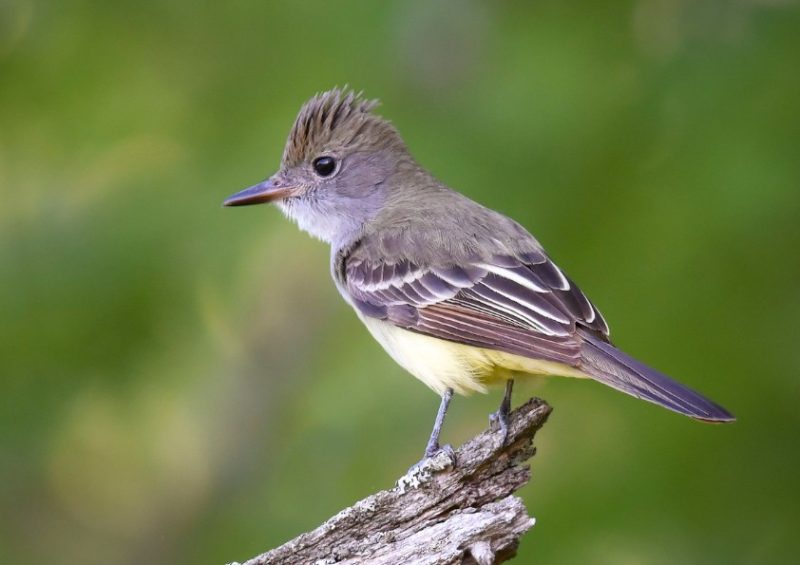
The Great Crested Flycatcher is a medium-sized bird with olive-brown upperparts, a bright yellow belly, and rufous-colored tail feathers that are often visible during flight. It has a distinctive crest on its head and a gray throat, along with a broad bill adapted for catching flying insects. This bird’s lively presence and energetic hunting style are common in Pennsylvania’s woodlands.
Measuring about 7.5 to 9.1 inches in length with a wingspan of 12.6 to 13.8 inches, Great Crested Flycatchers are known for their loud, rolling “wheep” calls. They catch insects on the wing, often sallying out from a perch to snatch prey midair. They also eat some fruits and berries, especially later in the season.
In Pennsylvania, Great Crested Flycatchers inhabit deciduous forests, forest edges, and wooded suburban areas. They nest in tree cavities or old woodpecker holes, sometimes using snake skins to line their nests. Their striking plumage and vocalizations make them an easily recognizable summer resident.
Eastern Phoebe
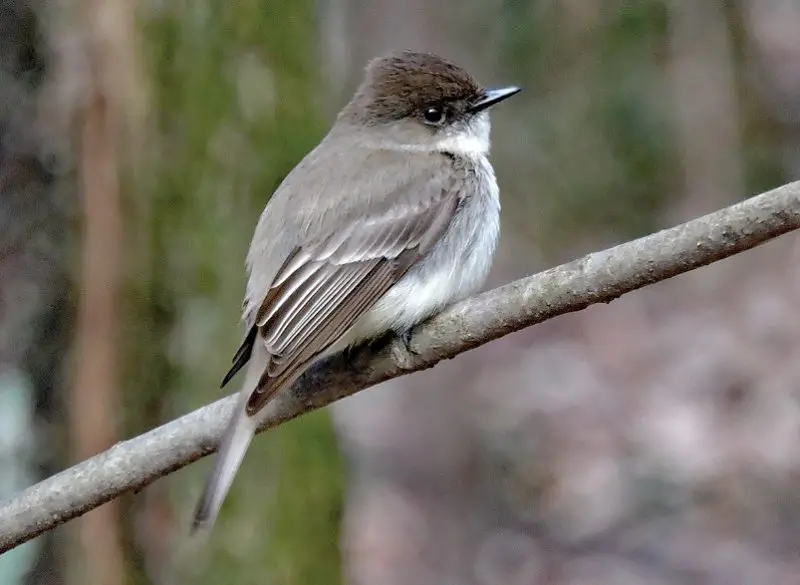
The Eastern Phoebe is a small, plain-looking flycatcher with gray-brown upperparts, a pale underbelly, and a slightly darker head. It lacks the bright colors of some other flycatchers but stands out with its distinctive bobbing tail and cheerful, raspy song. Its plain appearance belies an energetic and bold bird.
Measuring around 5.5 to 6.7 inches in length with a wingspan of 10.6 to 12.6 inches, the Eastern Phoebe sings a sharp “fee-bee” or “phoebe” call, which is often one of the first bird songs heard in early spring. It feeds on flying insects caught in short flights from a perch and sometimes gleans insects from vegetation.
In Pennsylvania, Eastern Phoebes are common breeders in open woodlands, farmlands, suburban areas, and near water sources. They frequently nest on human structures such as bridges, barns, and buildings, often returning to the same nest year after year. Their early spring arrival and cheerful song are signs of the changing seasons.
Eastern Wood-Pewee
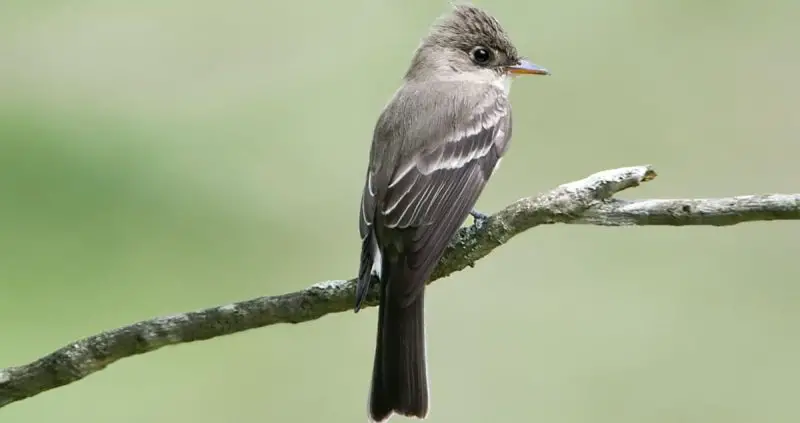
The Eastern Wood-Pewee is a small, drab flycatcher with olive-gray upperparts and pale underparts. It has a slender bill with a broad base and a faint eye ring. While not visually striking, it is often heard before it is seen due to its clear, mournful whistle. The bird’s modest plumage helps it blend into the leafy canopy.
This species measures about 6 to 7 inches in length with a wingspan of 11 to 13 inches. Eastern Wood-Pewees sing a clear, descending “pee-a-wee” or “pee-oo-wee” call during the breeding season. They forage by sallying from exposed perches to catch insects in midair.
In Pennsylvania, Eastern Wood-Pewees are summer residents found in mature deciduous and mixed forests, particularly in well-wooded areas with open understories. They arrive in late spring and leave by early fall to winter in Central and South America. Their subtle presence and haunting calls are a hallmark of summer woodlands.
Yellow-rumped Warbler
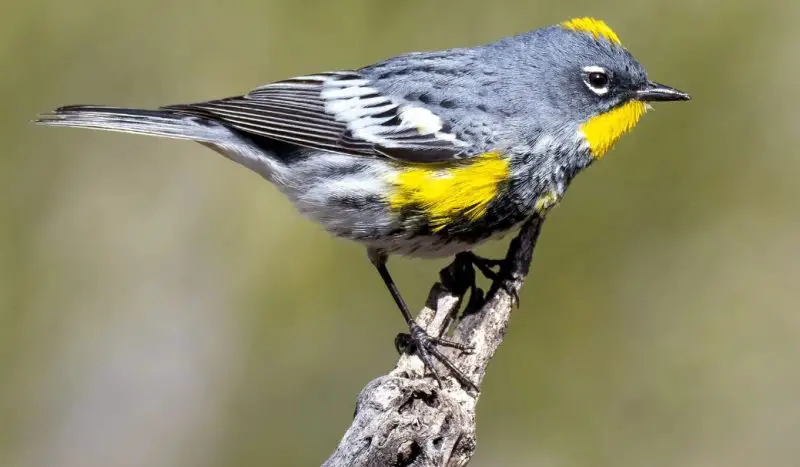
The Yellow-rumped Warbler is a medium-sized songbird known for its striking yellow patches on the rump, sides, and sometimes throat, contrasted with gray and white plumage. During the breeding season, males exhibit bold black streaking on a white chest and a distinct yellow throat patch. Females and non-breeding birds have duller colors but retain the yellow rump.
Measuring approximately 5 to 6.3 inches in length with a wingspan of 8.7 to 11 inches, these warblers have a sharp, musical trill and a buzzing flight call. They forage actively among branches and shrubs for insects and berries, with a diet shifting seasonally from insects in summer to fruits in winter.
In Pennsylvania, Yellow-rumped Warblers are common migrants and winter residents. They occupy a variety of habitats including forests, woodlands, and shrubby areas. Their ability to digest waxy berries allows them to winter farther north than most warblers, making them a frequent sight during colder months.
Black-and-white Warbler

The Black-and-white Warbler is easily identified by its striking black and white striped pattern on the head, back, and wings. Unlike many warblers, it forages by creeping along tree trunks and branches, similar to a nuthatch. Its behavior and plumage help it blend into the bark as it searches for insects.
This small warbler measures about 4.3 to 5.1 inches long with a wingspan of 6.7 to 8.7 inches. Its song is a loud, clear series of notes often described as “wee-see, wee-see, wee-see.” The bird is active and restless, frequently moving vertically and headfirst down tree limbs.
In Pennsylvania, Black-and-white Warblers breed in deciduous and mixed forests and are often seen in mature woodlands. They migrate through the state in spring and fall and winter mainly in the southeastern U.S. Their distinctive foraging style and contrasting plumage make them a favorite among birdwatchers.
American Redstart
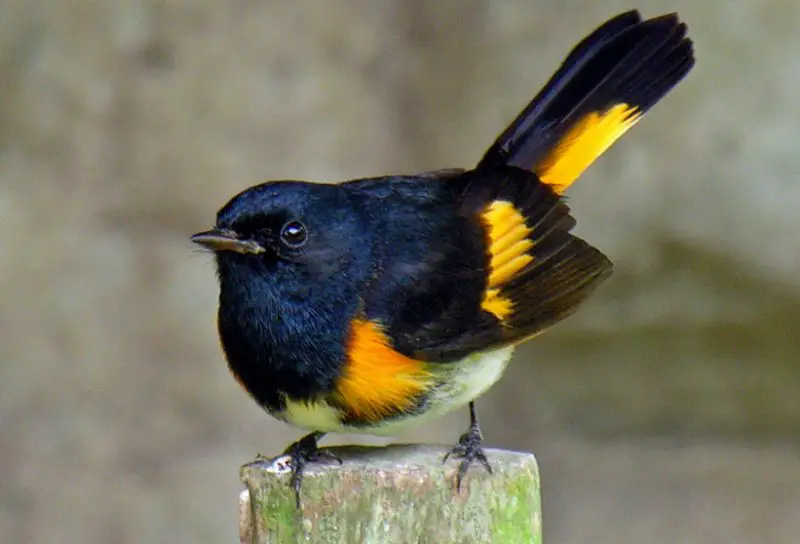
The American Redstart is a small, brightly colored warbler with males displaying black plumage with vivid orange patches on the wings, tail, and sides. Females are olive-gray with yellow patches in the same areas. Their active, fluttering behavior is characteristic as they catch insects midair or glean from foliage.
These birds measure about 4.3 to 5.1 inches in length with a wingspan of 6.7 to 8.7 inches. The male’s song is a series of high-pitched, musical phrases often repeated rapidly. Their energetic flight and vocalizations make them conspicuous despite their small size.
In Pennsylvania, American Redstarts are summer residents in deciduous forests, woodlands, and gardens. They favor dense foliage for nesting and feeding and are migratory, spending winters in Central America and the Caribbean. Their bright coloration and lively behavior are highlights of spring and summer birding.
Cooper’s Hawk
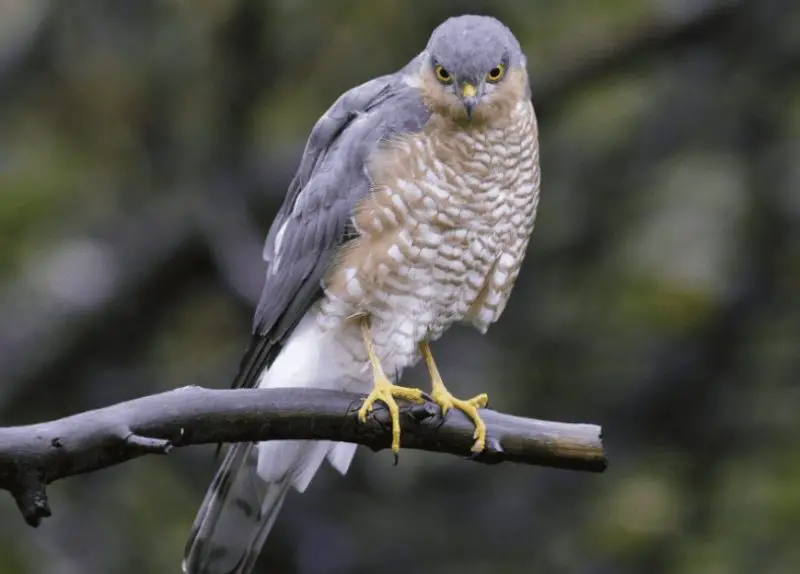
The Cooper’s Hawk is a medium-sized hawk known for its rounded tail with broad bands and relatively large head. It has a slate-gray back and wings with a barred reddish chest. Its yellow eyes and sharp hooked bill give it a fierce, focused expression. Cooper’s Hawks are agile predators specialized in hunting birds.
They measure about 14 to 20 inches in length with a wingspan of 24 to 35 inches. Their flight is fast and direct with quick wingbeats interspersed with glides. They use stealth and speed to surprise prey, often flying through dense woodlands and urban areas.
In Pennsylvania, Cooper’s Hawks are year-round residents found in forests, woodlots, and suburban areas. They often hunt smaller birds around feeders and nest in tall trees. Their presence helps control populations of smaller bird species, contributing to ecosystem balance.
Red-tailed Hawk
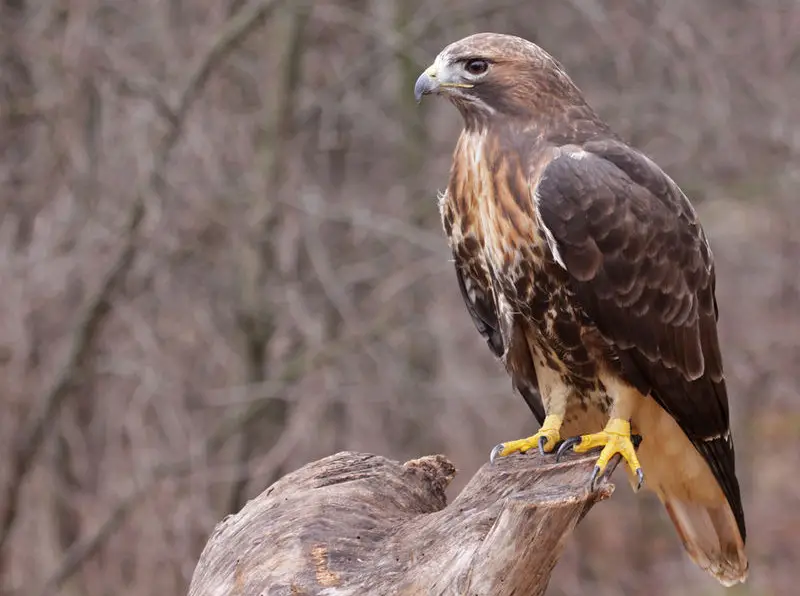
The Red-tailed Hawk is one of the most common and widespread raptors in North America, easily recognized by its rich brown back, pale underside, and distinctive brick-red tail. It has broad, rounded wings and a robust body, giving it a commanding presence in the sky.
This hawk measures approximately 18 to 26 inches in length with a wingspan of 43 to 57 inches. Its call is a loud, raspy scream often used in movies to represent any bird of prey. Red-tailed Hawks soar in wide circles while scanning open fields and wooded edges for small mammals, reptiles, and birds.
In Pennsylvania, Red-tailed Hawks inhabit forests, farmland, suburban areas, and highways. They build large nests in tall trees or on cliff ledges and are visible year-round. Their adaptability and impressive hunting skills make them a familiar and respected raptor.
Turkey Vulture
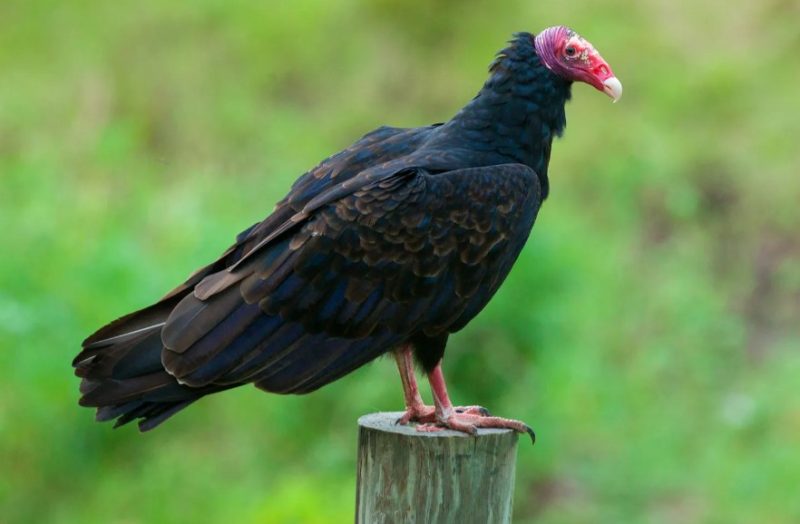
The Turkey Vulture is a large scavenger bird easily recognized by its bald red head, dark brown to black plumage, and broad wings with silvery flight feathers visible in flight. It has a keen sense of smell that helps it locate carrion from great heights, a rare trait among birds.
They measure about 25 to 32 inches long with a wingspan of 63 to 72 inches. Turkey Vultures soar in wide circles, often seen gliding effortlessly on thermals with wings held in a shallow V shape. Their distinctive, hissing calls are heard during social interactions at roost sites.
In Pennsylvania, Turkey Vultures are year-round residents that frequent open countryside, forests, and roadways. They play a vital ecological role by consuming dead animals and recycling nutrients. Their soaring presence is a common and important part of the state’s ecosystem.
FAQs about Common Birds in Pennsylvania
What are some of the most common birds found in Pennsylvania?
Pennsylvania hosts a diverse range of bird species, with some of the most common including the Northern Cardinal, American Robin, Blue Jay, Mourning Dove, and Black-capped Chickadee. These birds thrive in various habitats ranging from urban areas to forests and wetlands.
When is the best time to see migratory birds in Pennsylvania?
The best time to observe migratory birds in Pennsylvania is during the spring (April to June) and fall (September to November) migration periods. During these times, many species pass through the state on their way to breeding or wintering grounds, providing excellent birdwatching opportunities.
What habitats do common Pennsylvania birds prefer?
Common birds in Pennsylvania occupy a wide range of habitats, including deciduous and mixed forests, open fields, wetlands, suburban neighborhoods, and urban parks. For example, Woodpeckers prefer mature forests, while sparrows and finches are often found in open fields and backyard feeders.
How can I attract common birds to my backyard?
To attract common birds in Pennsylvania, provide a variety of food sources such as sunflower seeds, suet, nyjer seed, and fresh water. Plant native shrubs and trees for shelter and nesting, and offer birdhouses or nesting boxes suitable for local species. Maintaining a pesticide-free environment also supports healthy bird populations.
Are there any endangered or threatened bird species in Pennsylvania?
Yes, Pennsylvania is home to several bird species listed as threatened or endangered at the state or federal level, such as the Cerulean Warbler and the Eastern Bluebird (historically threatened but now recovering). Conservation efforts focus on habitat preservation and restoration to protect these vulnerable species.
Do birds in Pennsylvania stay year-round or migrate seasonally?
Some birds in Pennsylvania, like the Northern Cardinal and Black-capped Chickadee, are year-round residents. Others, such as the American Goldfinch and many warblers, are migratory, arriving in spring to breed and leaving in fall to spend winter in warmer climates.
What is the best way to identify birds in Pennsylvania?
Bird identification is best done by observing key features such as size, shape, plumage colors and patterns, behavior, calls, and habitat. Using a field guide or bird identification app can be very helpful. Listening to bird songs and calls is also an effective way to identify species, especially those that are visually elusive.

